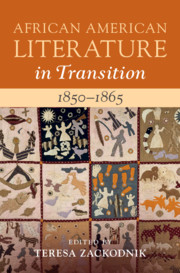Book contents
- African American Literature in Transition, 1850–1865
- African American Literature In Transition
- African American Literature in Transition, 1850–1865
- Copyright page
- Contents
- Figures
- Contributors
- Preface
- Chronology, 1850–1865
- Introduction
- Part I Black Personhood and Citizenship in Transition
- Part II Generic Transitions and Textual Circulation
- Chapter 5 Overhearing the African American Novel, 1850–1865
- Chapter 6 Black Romanticism and the Lyric as the Medium of the Conspiracy
- Chapter 7 Black Newspapers, Novels, and the Racial Geographies of Transnationalism
- Chapter 8 Creoles of Color, Poetry, and the Periodic Press in Union-Occupied New Orleans
- Chapter 9 The Haitian and American Revolutions and Black Historical Writing at Mid-Century
- Part III Black Geographies in Transition
- Bibliography
- Index
Chapter 7 - Black Newspapers, Novels, and the Racial Geographies of Transnationalism
from Part II - Generic Transitions and Textual Circulation
Published online by Cambridge University Press: 07 April 2021
- African American Literature in Transition, 1850–1865
- African American Literature In Transition
- African American Literature in Transition, 1850–1865
- Copyright page
- Contents
- Figures
- Contributors
- Preface
- Chronology, 1850–1865
- Introduction
- Part I Black Personhood and Citizenship in Transition
- Part II Generic Transitions and Textual Circulation
- Chapter 5 Overhearing the African American Novel, 1850–1865
- Chapter 6 Black Romanticism and the Lyric as the Medium of the Conspiracy
- Chapter 7 Black Newspapers, Novels, and the Racial Geographies of Transnationalism
- Chapter 8 Creoles of Color, Poetry, and the Periodic Press in Union-Occupied New Orleans
- Chapter 9 The Haitian and American Revolutions and Black Historical Writing at Mid-Century
- Part III Black Geographies in Transition
- Bibliography
- Index
Summary
The Black periodical is important in its materiality, circulation, and the serial possibilities it affords. This chapter asks us to think about the periodical not only as where mid-century Black literature can be found but also as a media technology that uniquely facilitated a “transition from a transnationalism routed through a white transatlantic sensibility to one grounded in a Black hemispheric imaginary” through serialization. The political import of serializing novels in the Black press from the early 1850s to early 1860s is explored, including Dickens’s Bleak House in 1853 in Frederick Douglass’ Paper, and Martin Delany’s Blake in the Weekly Anglo-African from 1861 to 1862. This chapter argues that these papers used serialization “to teach their readers how to relate the fight for Black freedom in the United States to transnational liberation movements.” While Bleak House taught readers not to be distracted by distant suffering, Blake’s serialization taught them that the Civil War was but one front of a Black hemispheric revolution. Haiti is located in an African American literary and political imaginary that was also mobilizing the Hungarian Revolution through serialized publication, meaning the political struggles at these sites could not be readily divorced from those of African Americans.
Keywords
- Type
- Chapter
- Information
- African American Literature in Transition, 1850–1865 , pp. 171 - 190Publisher: Cambridge University PressPrint publication year: 2021



